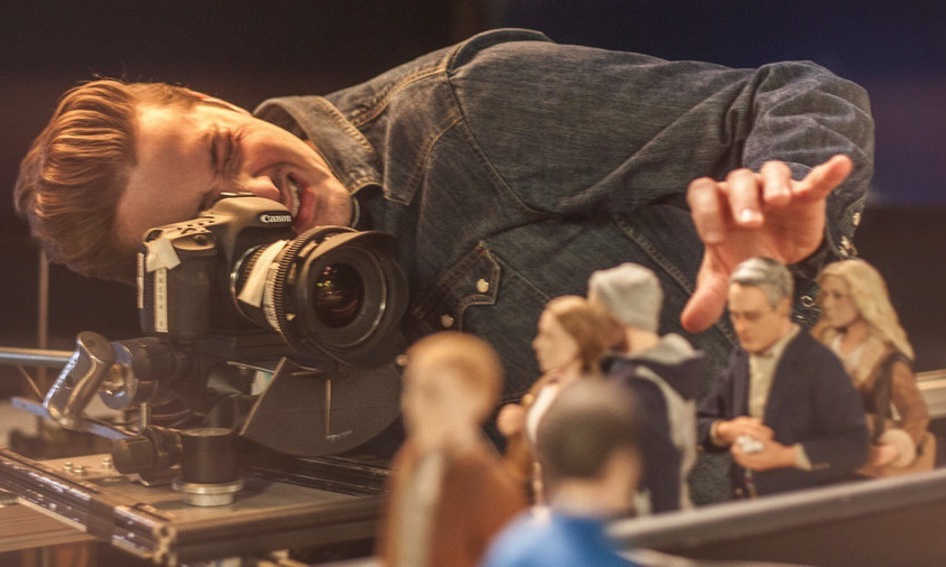
Co-director Duke Johnson sets up a painstaking shot in “Anomalisa.”
Photos Courtesy of Paramount Pictures
The 2016 winner for Best Animated Movie was Pixar’s look at the internal turmoil that befalls a tween girl. “Inside Out,” distributed by Walt Disney Pictures, showed the joy, the angst, the anger, and the sadness that wage war inside a child’s mind. Going up against the PG-rated juggernaut was an R-rated stop-motion film called “Anomalisa.” It was the first “adult” animated movie ever nominated for an Oscar, and it made history for that impressive feat. The film lost the statuette, but it garnered incredible reviews from professional critics, IMDB and Rotten Tomatoes reviewers, and in-the-know word of mouth.

Johnson and Charlie Kaufman oversee the dollhouse-size set. Photo by Ricardo DeAratanha/Los Angeles Times
Now, luckily for doll enthusiasts, this intriguing film is available to stream through several movie sites: Amazon Prime is among them, and the flick is free to Prime members. Written and produced by Charlie Kaufman (the genius behind “Being John Malkovich,” “Adaptation,” and “Eternal Sunshine of the Spotless Mind,” to name a few), the movie follows the interior struggle to find meaning and significance in a mundane and drudgery-filled world. Akin to “Inside Out” in that it focuses on a mental monologue, it parts company with the family-friendly film because this screenplay is definitely for adults-only viewers.
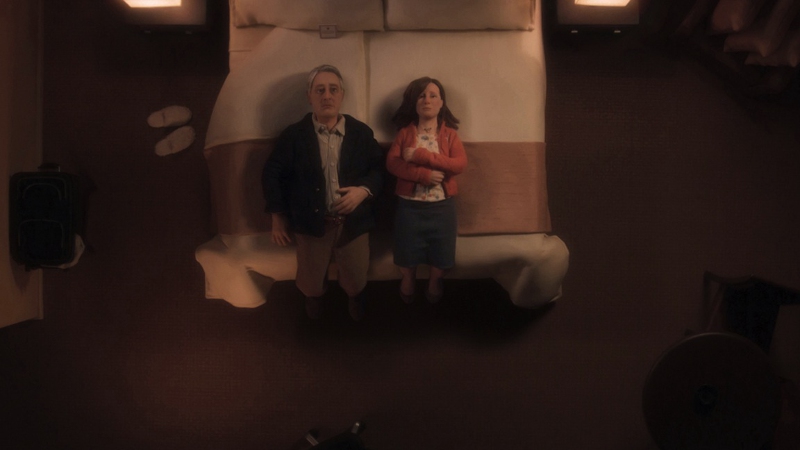
Michael and Lisa get intimate quickly, revealing their anxieties before sex.
The characters in this movie are all dolls made with 3-D printers. Regarding the two leads — think of Tom Hanks and Meg Ryan if they made a movie today as potential lovers. A collaboration of Hanks and Ryan in 2018 wouldn’t be a sweet, coy meditation on young, klutzy love. Rather, it would be a film about middle-aged people who might have been isolated for decades and have been pining for a significant other for 20 or more years. Perhaps their new pairing would be about a couple of folks that could have gone though the motions (even stop motions) about bonding with another, marrying, and doing the so-called “right things,” but have never felt that it was real.
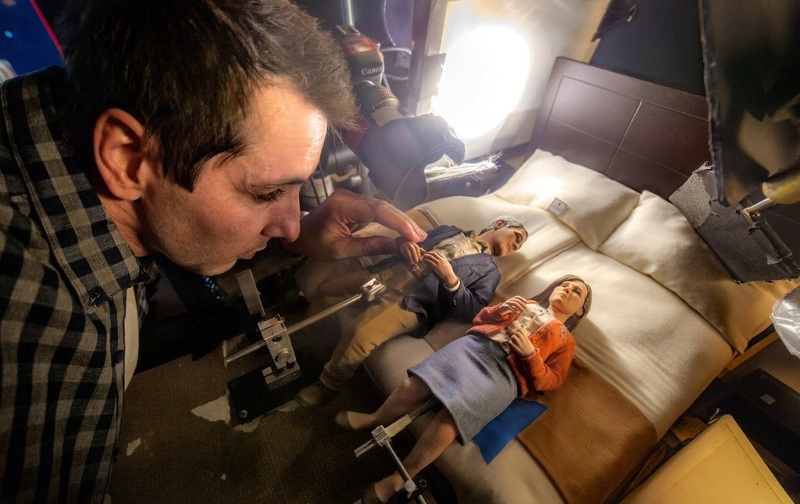
The crew positions the dolls for each shot.
That is the pulse of “Anomalisa,” which follows the overnight stay and crisis of the soul of a customer-service expert and motivational speaker voiced by British actor David Thewlis. Thewlis’s Michael Stone is joined by Jennifer Jason Leigh, who voices a young woman named Lisa Hesselman. Her character is impressed by the older man’s confidence, notoriety, and clout. Staying at a Cincinnati, Ohio, hotel, the two individuals cross paths, and Stone seduces the lonely and cautious Hesselman. (Again, this is an R-rated film, so the lovemaking scene is pretty graphic, even if it is utilizing fashion dolls.)

The “Anomalisa” cast: Tom Noonan, Jennifer Jason Leigh, and David Thewlis.
All of the other characters in the film resemble one another, intentionally. They are all voiced by actor/playwright Tom Noonan, and he speaks in the same intonation and vocal register for everyone else, regardless of whether it is a female or male, senior citizen or child, overly solicitous hotel worker or disinterested store owner. It’s not a case of sloppy acting or shoddy direction. The motivational speaker Michael Stone is suffering from extreme apathy. He has lost his love of life and purpose for living. He has fallen into a major depression whereby everyone — his wife, his child, colleagues, strangers — everyone has begun to look and sound the same. That is why he is so immediately drawn to the young hotel guest Lisa. She doesn’t look or sound the same; she is unique. She is an anomaly. He nicknames Lisa “Anomalisa” because of her distinction. She has broken through his distorted world view and psychological weariness.
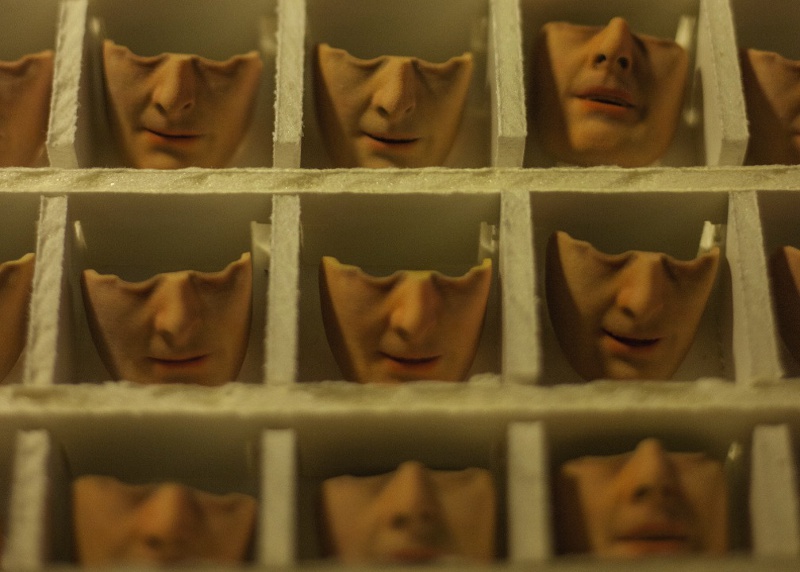
The many faces of Michael Stone.
The cast of characters were made via 3-D printers where the same face was replicated over and over again. The bodies and wigging were different but all of the people that Michael Stone encounters are the same doll face just plunked down on a different torso. For Michael and Lisa, the animators made 18 Michael dolls and six Lisa effigies. The posing of the dolls was absolutely essential to help convey what they were experiencing as Michael and Lisa plunge headfirst into a rapidly moving, personally jarring relationship. Michael is posed as the aggressor: the man is an expert at customer service, and most of his movements and behavior showcase a person who is able to be persuasive even when he is not so sure of his own sanity.

Lisa is the embodiment of insecurity, vulnerability, and loneliness.
The character of Lisa is absolutely heartbreaking. Her face has a scar on it — one that she attempts to hide with her hairstyle. Her physical vulnerability and emotional fragility are so intense that they break down Michael’s psychological wall. He CAN SEE her for who she is, and she foolishly believes that they can have a future together. Again, this is not a Disney film. The odds of a happy-ever-after occurring after a hookup in a Cincinnati hotel room are slim to none, and the filmmakers don’t shy away from this. The move is resoundingly realistic even though it is populated by somewhat-lifelike dolls.

Michael is lost, adrift in an endless corridor of same-looking rooms and doors.
Co-directed by Kaufman and Duke Johnson, the film will touch most viewers who are willing to let it unfold, and especially those who are open-minded enough to invest time in a movie that stars dolls. It chronicles the boredom of an out-of-town business trip, the sameness of city landscapes and airport terminals, the interchangeable nature of hotel lobbies and endless hotel rooms. It’s no wonder that the anti-hero of the film can no longer recognize or distinguish anything.

Michael wipes away the steam to see his own face in the mirror.
Showing just how clever Kaufman is, the hotel where the action takes place is named Fregoli, which is what this psychological disorder is called. (The Fregoli delusion is a belief that different people are actually a single person who changes his appearance or is in disguise.) The sets and the costumes have that look of familiarity and luxury that are supposed to comfort travelers away from home, assuring them that they are in good hands and will be treated well. But as the movies have shown us recently (especially George Clooney in “Up in the Air” and Ed Helms in “Cedar Rapids”), life on the road for all corporate players, whether they are bigwig hatchet men or hayseed peons, can be soulless and soul-crushing.
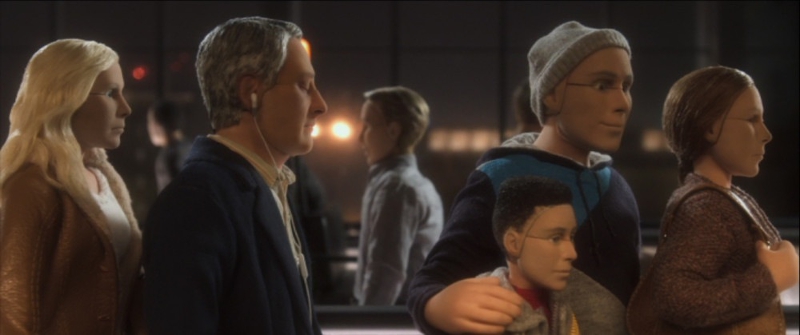
The conveyor-belt sameness of Michael Stone’s life.
“Anomalisa” shows the stripping away of humanity, decency, and individuality in a brilliant way. Its doll performers are haunting to watch, and the three actors who give them life are marvels to hear. It is not a film for children; it is a movie that should speak loudly and clearly to grown-ups who have wondered about their own role on the hamster wheel of existence. The dolls convey life’s conveyor-belt moments beautifully: they are all just passing by, passing time, doing what they have to do to pass the days and to pass away. It is quite an accomplishment, and doll collectors should give it a try. You’ll never look at your dolls’ potential the same way again.
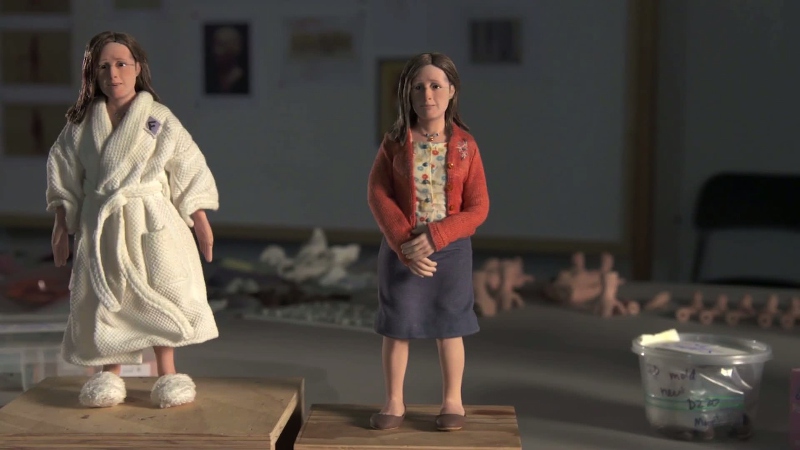
Two views of Lisa, one of the most real characters in film “romances.”






